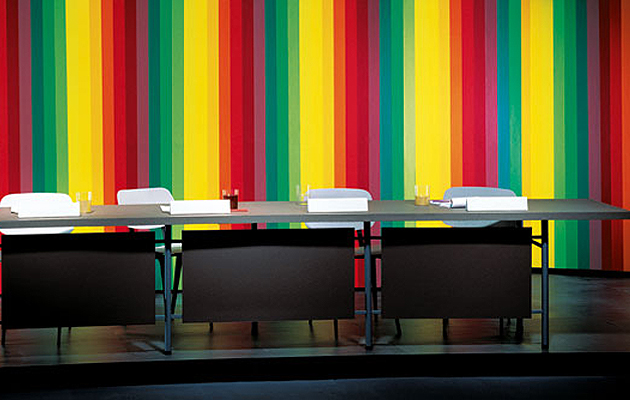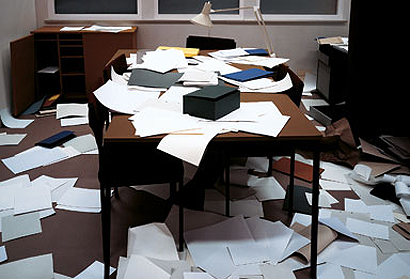|
Studio, 1997 (image: Thomas Demand) |
||
|
Germany’s complex national psyche is explored with paper and scissors in Thomas Demand’s searching show, says Sophie Lovell. In 2009 Germany marked two decades since the fall of the Berlin Wall and the 60th birthday of the German Federal Republic with cultural events and – true to form – a generous measure of introspective analysis. Art is an ideal medium to explore the nation’s complex collective psyche, and one artist in particular, Thomas Demand, does this with brooding, understated sensitivity. Munich-born Demand works with his generation’s media memories in paper. In his studio, he builds perfect 1:1 paper replicas of scenes: a kitchen, a ransacked office, a bathroom, a bus stop, all exquisitely precise but with the fine detail missing. Human life is also conspicuous by its absence from Demand’s tableaux. When complete, he photographs the models and then destroys them. The resulting large-format prints are representations of representations of representations of locations where events occurred that form part of the collective memory of the nation. The original images of these scenes, populated with politicians, citizens, celebrities and sometimes bodies, were replicated thousands of times across the country’s media pages and screens. Thus the plundered Office (1995), for example, corresponds to the former Stasi HQ in Berlin’s Normannenstrasse stormed by demonstrators in January 1990; the blue-tiled Bathroom (1997) mirrors the press photo showing the body of Schleswig Holstein’s former minister president, who met a violent end in a Swiss hotel bath; and the bus stop turns out to be the home town, Saturday night hangout of the pop group Tokyo Hotel. A week before the beginning of Berlin’s big annual autumn art fair, the Art Forum, a major new exhibition of some 40 works by Demand opened in Berlin at the Mies van der Rohe’s Neue Nationalgalerie. Appropriately entitled National Gallery, this show throws up as many questions as answers; an intriguing web of contradictory and competing references. The interior space has been divided up by Caruso St John with some 5km of floor-to-ceiling wool drapes, courtesy of the Danish firm Kvadrat, which Demand’s giant glossy prints hang on – and compete with. Then there are a number of rather stylish vitrines in front of each image containing texts by the celebrated German author and playwright Botho Strauss that respond to and also compete with the pictures in their own way. Such is the (not displeasing) struggle for dominance in this constellation of creative input that one begins to wonder why the exhibition is not credited to all these protagonists. Somehow the combination is just right, and a vibrant and highly complex mix of the representative and implicated, touching on intention, chance and history, ensues. There are no clear-cut positions or linear progressions in our 21st-century culture. There is no single way out of the labyrinth any more because everything happens simultaneously. A convergence of events led to the speedy fall of the Wall 20 years ago. A new country and infrastructure has been forged over a remarkably short period of time but this did not follow a linear path either. Today’s unified Germany is ever more a collection of federal states under successive national, European and global umbrellas. In this respect, Demand’s exhibition reflects the state of the nation: a complex, media-led web of threads that make up and at the same time negate a contemporary national identity.
Office, a recreation of the looted Stasi offices in Berlin, 1995 (image: Thomas Demand) Thomas Demand is at the Neue Nationalgalerie, Berlin, until 17 January 2010 |
Words Sophie Lovell |
|
|
||





















